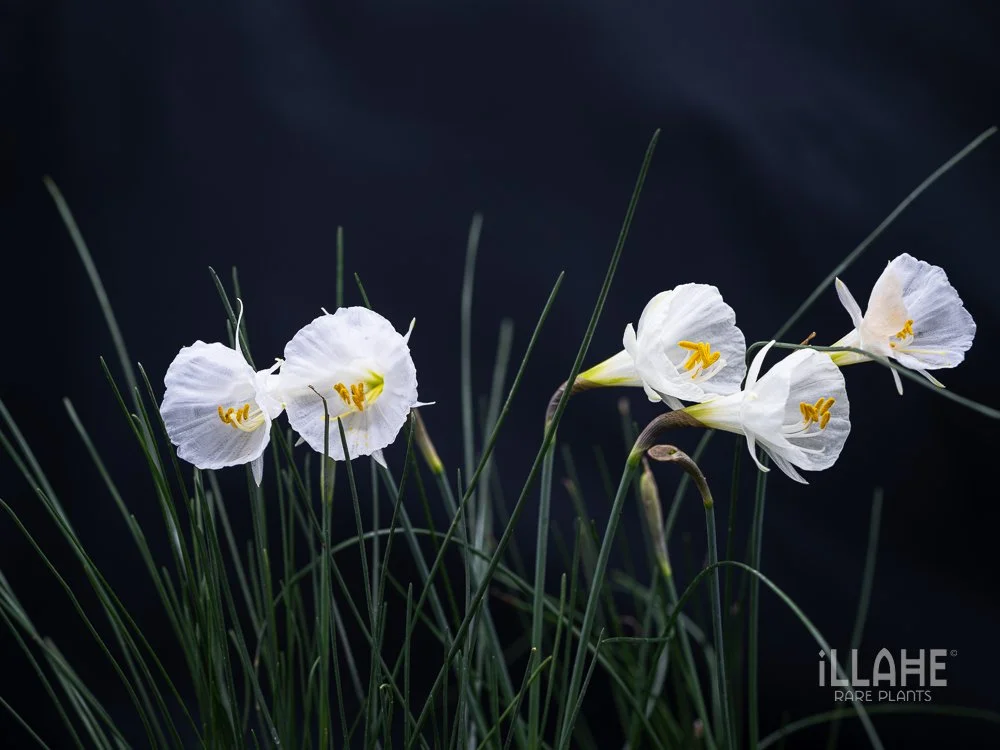
Narcissus nevadensis
A true gem among the wild daffodils, Narcissus nevadensis is a rare and captivating species endemic to the limestone cliffs and alpine meadows of the Sierra Nevada mountains in southern Spain. It thrives in well-drained, rocky soils where winter snowmelt provides essential moisture, followed by hot, dry summers — a true Mediterranean alpine cycle. Quite rare and considered endangered in it’s native habitat, the reasons are many, loss of unique habitat to development, overgrazing, mining activity in it’s extremely limited range, climate change resulting in lower pollinator numbers thus exacerbating slow recruitment rates. The tale is the same for so many plants, if you grow this in your garden, know that you are the keeper of something in peril of being lost to all of humanity.
This miniature daffodil produces elegant, nodding flowers with a pale yellow/white perianth and a slightly darker corona, typically blooming in early spring. Its foliage is fine and grass-like, staying low to the ground and making it particularly well-suited to troughs, crevice gardens, and other carefully managed alpine settings.
Cultivation requires a sharply drained substrate with a high mineral content — a gritty, lime-rich mix is ideal. N. nevadensis. My typical bulb mix contains a lot of pumice and lately I have been adding a bit of biochar and crushed oyster shell to the limelovers. This species does best with protection from summer moisture and excessive winter wet, especially in climates with heavier rainfall. In cultivation, it can be grown under glass or in a bulb frame to replicate its native habitat, though success is also possible outdoors in rock gardens with a dry summer regime.
Hardy to approximately USDA Zone 6b (down to -5°F / -20°C) if kept dry during dormancy, this species is not for the casual gardener but rewards careful cultivation with its exquisite beauty and rarity. A must-have for alpine plant enthusiasts and collectors of Mediterranean bulb species.
A true gem among the wild daffodils, Narcissus nevadensis is a rare and captivating species endemic to the limestone cliffs and alpine meadows of the Sierra Nevada mountains in southern Spain. It thrives in well-drained, rocky soils where winter snowmelt provides essential moisture, followed by hot, dry summers — a true Mediterranean alpine cycle. Quite rare and considered endangered in it’s native habitat, the reasons are many, loss of unique habitat to development, overgrazing, mining activity in it’s extremely limited range, climate change resulting in lower pollinator numbers thus exacerbating slow recruitment rates. The tale is the same for so many plants, if you grow this in your garden, know that you are the keeper of something in peril of being lost to all of humanity.
This miniature daffodil produces elegant, nodding flowers with a pale yellow/white perianth and a slightly darker corona, typically blooming in early spring. Its foliage is fine and grass-like, staying low to the ground and making it particularly well-suited to troughs, crevice gardens, and other carefully managed alpine settings.
Cultivation requires a sharply drained substrate with a high mineral content — a gritty, lime-rich mix is ideal. N. nevadensis. My typical bulb mix contains a lot of pumice and lately I have been adding a bit of biochar and crushed oyster shell to the limelovers. This species does best with protection from summer moisture and excessive winter wet, especially in climates with heavier rainfall. In cultivation, it can be grown under glass or in a bulb frame to replicate its native habitat, though success is also possible outdoors in rock gardens with a dry summer regime.
Hardy to approximately USDA Zone 6b (down to -5°F / -20°C) if kept dry during dormancy, this species is not for the casual gardener but rewards careful cultivation with its exquisite beauty and rarity. A must-have for alpine plant enthusiasts and collectors of Mediterranean bulb species.







